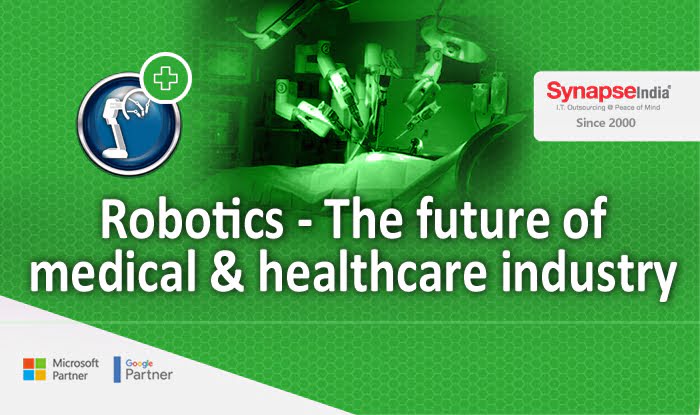 06 Sep 2019
06 Sep 2019“This blog talks about the role of robotics in the growth of the medical & healthcare industry. Various types of medical robots are discussed that are helpful for healthcare organizations and patients.”

Robotics is a futuristic technology that is being used by various industries across the globe. Diverse businesses are investing in robotics to automate processes, increase accuracy & productivity and cut down costs. The technology deals with the design, development and application of robots.
Robotics was initially utilized by the manufacturing and automobile industries for the automation of machinery. With technology advancements, numerous businesses are now using actual robots for multiple purposes.
Here, we summarize top ways how robotics is adding innovation and efficiency to the medical & healthcare industry:
Robots have completely changed the medical and healthcare sector. According to a recent report, the global medical robotics market is expected to grow to $20 billion by 2023. Various types of robots are used not for easing out the tasks of medical professionals but also for delivering high-quality care to patients.
Surgical assistants:
Used by surgeons for performing operations with maximum precision. Gone are the days when surgeons have to manually operate a patient. Now, it's a new world where robot-assisted surgeries or robotic surgeries have added a new lifeline to the medical & healthcare industry.
Robotic surgeries are advantageous to both surgeons and patients. Robot-assisted surgeries require a shorter hospitalization time and smaller incisions. Recovery time is faster and operated patients can return to normal activities in a few days.
Patient rehabilitation robots:
Rehabilitation robots help patients to recover from disabilities and increase mobility, strength and coordination. Such robots are adapted according to the conditions of patients.
Robotic therapy is a new field that has proven helpful for the medical industry. Robots offer a large variety of exercises for the therapist to choose from and measurable results can be achieved in less time.
Telepresence robots:
Medical professionals use telepresence robots to examine and treat patients from distant locations. Usually utilized by physicians of urban areas to treat patients residing in rural areas.
Previously, people who live in remote areas were unable to get high-quality care due to lack of modern medical facilities in their local areas. With the advent of remote presence robots, the situation of healthcare services has improved a lot in rural areas.
Disinfection robots:
Disinfection of medical rooms is a regular practice that is carried out by hospitals and healthcare centers. However, the use of high-power UV rays for disinfection is quite risky for professionals who do this task. Disinfecting robots sterilize medical rooms without any role of human beings.
Germicidal robots are quick, efficient and cost-effective. Their ability to move into areas where hands of humans don't usually reach make them a better option for sterilization of hospital rooms.
Robotics in drug discovery and development:
Use of robots in the development of innovative drugs have significantly increased in the last few years. Now, pharmaceutical companies are relying on robotics and artificial intelligence (AI) for various drug discovery processes.
Companion Robots:
Companion robots are being used by various healthcare organizations that work for the welfare of elderly people and single children. Social isolation is not only stressful but also results in various health problems. Companion robots act as an extended family member and support older people & children in their various day-to-day activities.
Future of medical robotics
Medical robotics has an exciting future. With a focus on better patient care and training of medical professionals, the use of medical robots will continue to increase. It will help the medical & healthcare industry to offer better services and earn higher profits. We can expect next-gen robots to behave, look and act like human beings.


